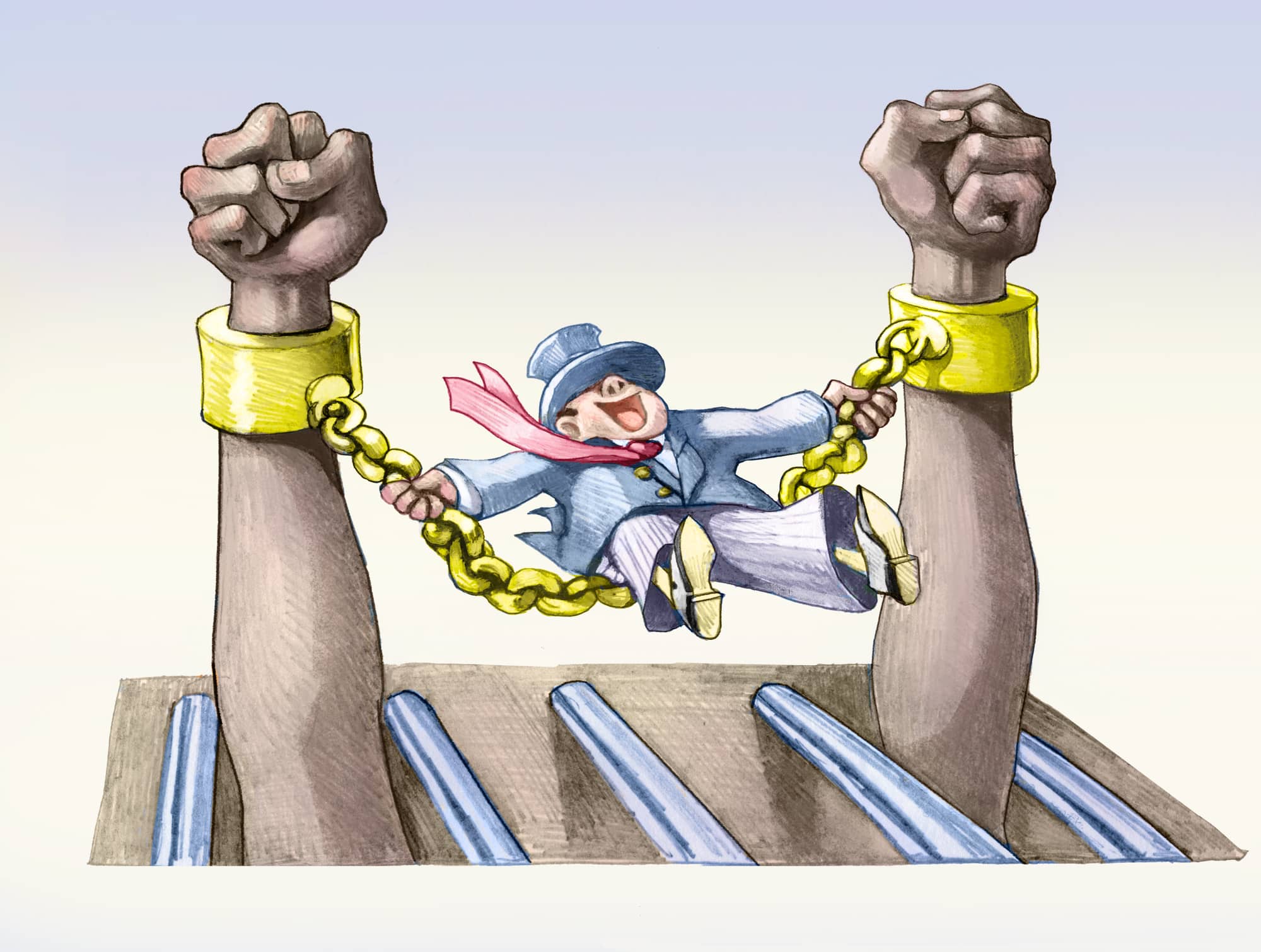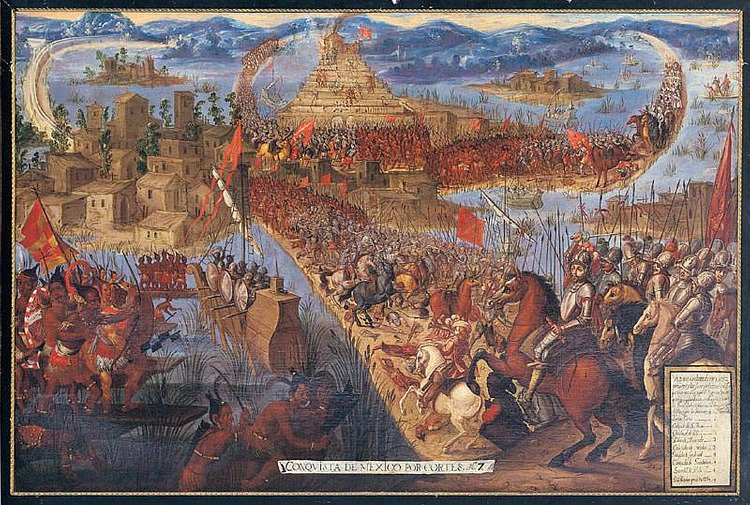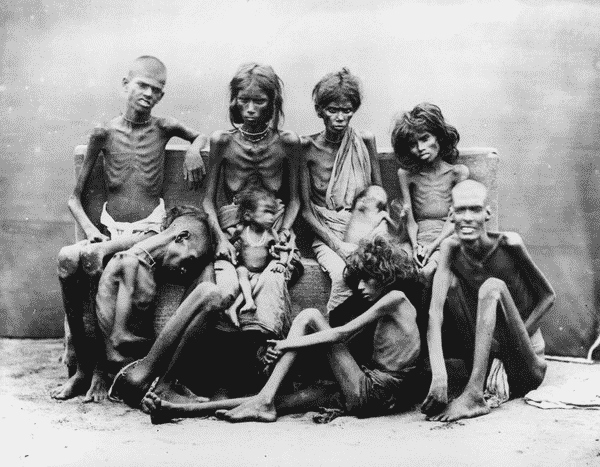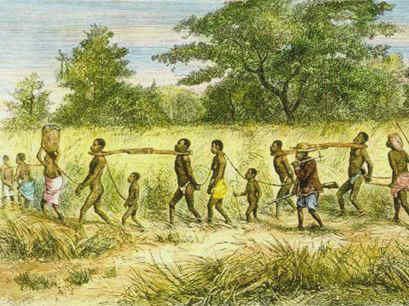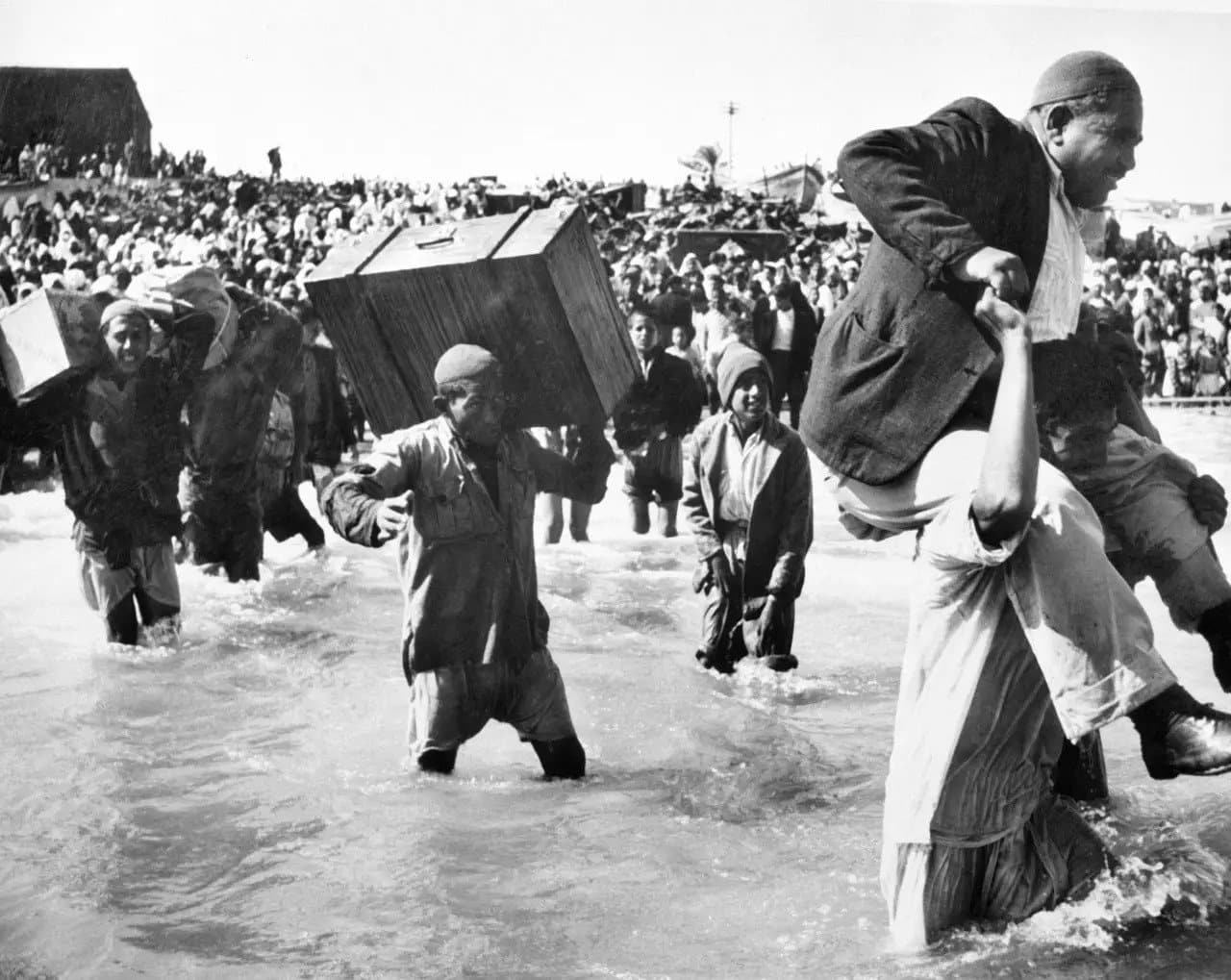Indian goods, like spices, silk, and textiles, had always been in great demand all over the world. So, merchants from various parts of the world often traveled to India for trade. This made India one of the wealthiest countries in the world at that time (in 1700). Its economy made up nearly 25% of the global economy. India’s economy was even larger than the economies all of the countries of Western Europe put together.
But within a span of 250 years, that number had shrunk to just 3%.
Now let’s turn our attention to the other part of the world, the Americas. It was home to two of the greatest civilizations of that time, the Incas and the Aztecs. Both these empires built sophisticated structures and complex cities filled with some innovative technologies. They built suspension bridges, built terraces for growing plants in areas with heavy rainfall, and predicted earthquakes. But at the same time, they also worshiped animals and forces of nature and lived in harmony with nature. The regions of the Americas, which the Incas and the Aztecs did not occupy, were occupied by numerous tribes ruled by priestly chieftains. Despite fighting locally among themselves, these tribesmen lived their entire lives in a relatively peaceful manner. They spent their time farming and lazing around, without a worry in the world.
And yet, within a span of 100 years, thousands of these indigenous people in the Americas had been raped, tortured, or killed. Some of these tribes, like the Taino, had vanished entirely.
A depiction of Spanish atrocities in Cuba -By Joos van Winghe – Peace Palace Library, Public Domain, Link
The two tragic cases above might sound completely unrelated to each other. But they were both caused by a single event – colonialism.
What is colonialism?
I am sure that we all know what colonialism is. It is a practice where a powerful country controls other weaker countries directly and utilizes their resources and manpower to increase its own wealth and power. The countries that exert such control over other weaker countries are called colonizers. The countries that end up being controlled by them are called colonies.
The main reason for colonization was to procure resources from colonies. But during the process of colonization, colonizers also imposed their languages, religions, and cultures over their colonies. By doing so, they often destroyed the cultures of these colonies and the identities of people. In some colonies, the colonizers even actively decimated thousands of people and entire races for their own amusement. So, regardless of how you see it, colonialism was a global disaster, except for the colonizers, who benefited greatly from it. Even though colonialism started long before the birth of Christ, in this blog post, we will discuss only European colonialism.
When and how did it start?
In the middle ages, traders actively traded along the silk route, bringing goods from Asia and Africa to Europe. These goods (silk, ivory, dye, honey, tea, spices, paper, rice, fur, woolen goods, cattle, etc.) were indispensable for Europeans. So, it wouldn’t be far-fetched to say that the Europeans depended heavily on the silk route.
In the 15th century, the Ottoman Empire defeated the Byzantine Empire and came to power. Once it came to power, the Ottoman Empire closed the silk route to Christian traders. This was devastating for Europeans because they couldn’t get their hands on the goods the silk route had previously provided. Moreover, they had used massive amounts of gold and silver to pay for the goods from the silk route. Hence, they were running out of their reserves of gold and silver as well. So, they were not only desperate to get their hands on the Asian goods, but also wanted to procure gold and silver. Therefore, many European kingdoms started sponsoring voyages to find alternative routes to Asia. Thus, the age of exploration began.
Spain and Portugal were the first countries to enter this exploration race. Each of these countries sponsored different explorers who discovered different territories. Portugal sponsored Vasco da Gama, who sailed East and found the route to India. Spain sponsored Christopher Columbus, who sailed West hoping to find a faster route to Asia because the Earth is spherical but landed in America instead. These discoveries started Europe’s colonization of the rest of the world.
Different types of colonialism
Settler Colonialism
Upon landing in the unexplored Americas, Columbus found the local native people to be weaker and less civilized than Europeans. So, he started conquering them, despite the native people being hospitable and helping them. He even made some of his men settle there before returning to Spain.
Huge Influx of settlers
Columbus’ discovery of unexplored regions came as good news for Spain. Excited by the possibility of finding riches in these unknown lands, Spain started sponsoring more voyages. Its efforts bore fruit soon when its explorers found gold in South America, Central America, and Mexico. Spain grew rich from these exploits, and many people started moving from Europe to the Americas and settled there in the hopes of finding gold.
Christian missionaries also sent people to the Americas to settle there and convert the native people to Christianity. The ability to cultivate cash crops, like tobacco, in the Americas also motivated many Europeans to settle there.
Decimating the native population
These settlers built their own churches, schools, and farms while maintaining political and economic ties with their home country. They created their own communities in the new land. But by doing so, they killed and displaced the Aztecs, Incas, and the other indigenous people of the Americas. For instance, in the USA alone, the population of indigenous people fell by 57% between 1700 and 1820.
A 17th-century CE oil painting depicting the Spanish Conquistadores led by Hernán Cortés besieging the Aztec capital of Tenochtitlan in 1519 CE. (Jay I. Kislak Collection)
The colonization of the Americas is a typical case of Settler colonialism. In settler colonialism, the goal of the colonizing country is to establish its own branch there. So, it tries to replace the original population of the colony by settling its own people there. The settlers, the people who move from the colonizing country and settle in these colonies, are often considered racially superior to the native people there and enjoy greater benefits. So, settlers move along with their families to these colonies to live there. In contrast to other forms of colonialism, in settler colonialism, the settlers continue to live in the colonies even after the colonial empire comes to an end. The USA, the Apartheid South Africa, Australia, and Canada are some of the victims of settler colonialism.
Exploitation Colonialism
When the Portuguese, headed by Vasco da Gama, landed in India, their primary goal was to establish trading ties with the country. So, the Portuguese started purchasing spices and selling them to the European high class. But the trade became so profitable that other European countries jumped in too.
Establishing trading companies
The British East India Company started only as a small business in London. But soon, it established outposts in the Indian cities of Bombay, Madras, and Calcutta. Unlike its European counterparts, the company was able to win the trust of the Mughal Empire that ruled most of India and make several trade agreements. These agreements made trade very profitable for its shareholders. But in a few years, the Mughal Empire weakened due to internal political divisions and invasions from neighboring Persia. Therefore, the East India company utilized the opportunity to expand into the Mughal provinces. By 1757, many wealthy Mughal provinces were under its control.
Effect of the Industrial revolution
Initially, the company brought its skilled craftsmen to produce finished goods (like clothes) in India. But with the onset of the Industrial Revolution, Europe started producing goods faster in its own land. Therefore, it needed enormous amounts of raw materials and a huge market to sell its products. So, India (and many other colonies) was forced to produce these raw materials (e.g., cotton). Hence, Indians were forced to prioritize the production of cash crops (cotton, tea, coffee, sugar, etc.) more than food items. So, the price of these raw materials went down, and the cost of food items went up.
Moreover, Indians were taxed for living under regions controlled by the East India Company. India, with its huge population, was also an important market for Britain. So, Indians were also forced to buy the finished products from Britain (like clothes). As a result, Britain became richer, while India became poorer. These cash crops also destroyed the fertility of the soil leading to droughts and famines. As a result, millions of Indians starved to death. Yet, while Indians kept dying due to starvation, Britain kept exporting tonnes of wheat from India to Britain.
The Odisha famine of 1866, which killed more than 4 million people – Willoughby Wallace Hooper, Public domain, via Wikimedia Commons
Few colonizers control an entire colony
The industrial revolution also directly contributed to colonialism by equipping Europeans with improved machinery and superior weapons. New improvements in medicines also helped Europeans penetrate deep into their colonies safely, where previously they had encountered severe casualties. The company built trains to quickly transport the raw materials and used new gun types to overpower the masses. As a result, within the next hundred years, the East India Company became extremely powerful. It recruited Indians and trained them in European warfare, thereby creating an army of 260,000 soldiers. With this army, it was able to convert India into a British colony and rule its enormous population of 200 million people with ease.
The colonization of India is a typical case of Exploitation colonialism. In exploitation colonialism, the Colonizing country captures colonies with the sole intent of exploiting their cheap labor to extract raw materials for its immediate financial gain. In contrast to settler colonialism, the profits are not reinvested into the colonies. Once the colonial empire comes to an end, the colonists leave the colonies. Many Asian and African countries are victims of exploitation colonialism.
Plantation colonialism
The Europeans came to the Caribbean islands looking for silver and gold. But they didn’t find much of these precious metals there.
Identifying a cash crop
So, they started to grow different crops in the region to take them back home and sell them there. After experimenting with several plants (including tobacco), they tried growing sugarcane there. Even though sugarcane wasn’t a local crop of the Caribbean, it grew well.
Sugarcane was a highly beneficial crop. It could be used to make sugar, which was used to make food products like chocolate or mixed with food products like tea and coffee. It could also be used to make alcoholic beverages like rum. Both sugar and rum were in high demand in Europe. So, sugarcane plantations became a highly profitable business. For instance, in 1789, Saint-Domingue, a French colony in the Caribbean islands, produced 40% of the world’s sugar. Hence, it became the most valuable colony on Earth. So, the planters, which is how the people who created these plantations were called those days, became wealthy very quickly. And understandably, their success motivated many more Europeans to travel to the Caribbean islands and start sugarcane plantations.
Bringing slaves to meet labor demand
This surge in the sugarcane plantations created a huge demand for workers. So, millions of African men, women, and children were enslaved and brought to the Caribbean islands to work. As a result, the number of slaves far exceeded the number of planters. By the eighteenth century, slaves constituted at least 90% of the population of the Caribbean islands.
African slaves being brought to work in plantations (Source)
But the working conditions in these plantations were so harsh that many slaves died without reproducing. So, the slave population always kept shrinking, and to keep it steady, fresh slaves were imported from Africa constantly. To justify their inhuman treatment of slaves, Europeans invented the idea that they belonged to a superior race. So, it was their right to civilize, or in other words, exploit the Africans, who, in their view, belonged to an inferior race.
The colonization of the Caribbean islands is a classic example of plantation colonialism. In this type of colonialism, settlers create colonial bases for the mass production of a single crop, like sugar, coffee, cotton, rubber, etc. More often than not, slaves are imported to meet the demand for cheap labor. The Caribbean islands and many regions in North America are victims of plantation colonialism.
Surrogate colonialism
Until the first world war started, the Arabs in Palestine and its neighboring regions were ruled by the Ottoman Empire. Until then, nobody cared about them.
Meddling in the internal affairs of another country
Once the first world war started, Britain wanted these Arabs to fight on its side. Moreover, it wanted to maintain the support of the Muslims in the Indian army who were fighting for it. So, it agreed to the Arabs’ demand to let them establish their own kingdom in the region once the Ottoman Empire was defeated. In return, the Arabs had to revolt against the Ottoman Empire. This agreement was made between 1915 and 1916 over a series of ten letters exchanged between the Sheriff of Mecca, Hussein bin Ali, and the British High Commissioner to Egypt, Lieutenant Colonel Sir Henry McMahon, which came to be known as the McMahon–Hussein Correspondence.
But despite making this agreement, Britain signed a separate agreement with France in 1916. In this agreement, the Sykes-Picot agreement, Britain promised that most of Palestine would be administered internationally. The rest of the region would be divided up between France and Britain. As you can see, this agreement directly contradicted the McMohan-Hussein Correspondence.
As the first world war progressed, Britain’s success in the war became questionable. Even though the USA was sending its troops to aid Britain, it would take one more year for its full force to reach all the fronts. So, Britain wanted to gain the support of the Jews, particularly in the USA and Russia. After all, the Jewish population in Russia had recently helped overthrow the anti-Semitic Czarist Russian government there. If Britain could win their support, Russia could re-enter the war on the Eastern Front against Germany. Moreover, it wanted to exert its dominance in Palestine, a place that was like a bridge between Egypt and India. And finally, it genuinely wanted to support the Zionists’ cause of establishing a country where they could live.
Giving superiority to a non-native group over the native people
So, Britain decided to support the establishment of a national home for the Jews in Palestine. But it wished to achieve this goal without endangering the rights of the already existing non-Jewish people in Palestine. Britain revealed its decision through a letter written to a prominent Zionist head. This letter, which came to be known as the Balfour Declaration, was in direct opposition to the McMohan-Hussein Correspondence and the Skyes-Picot agreement.
The Balfour Declaration permitted Jews to establish a country, where the native Arabs constituted more than 90% of the population. The majority of these native Arabs were against the Balfour Declaration. They were outraged for not being permitted to establish their own nation, which they were promised in return for their participation in the war against the Ottoman Turks. To portray the sentiments of the Palestinians, I would like to quote the words of the late Palestinian-American academic Edward. According to him, the Balfour Declaration was “made by a European power … about a non-European territory … in a flat disregard of both the presence and wishes of the native majority resident in that territory.”
Following this Declaration, thousands of Jews started immigrating from all over Europe to Palestine. As a result, the population of Jews in Palestine tripled within two decades, and with it, the violence between Arabs and Jews escalated as well.
Non-Native groups displace native people
As the violence between both these factions escalated, Britain finally decided to terminate its mandate in 1947. It wanted to transfer the Palestine problem to the United Nations. But by that time, it was already too late. The Jews had already created an army using the armed paramilitary troops which Britain had trained to fight in the second world war. One year later, the Jews used this same army to forcefully oust almost 80% of the ethnic Arabs from their homeland and created the country of Israel.
Arabs fleeing Palestine, 1948 (Source)
What happened in Palestine is an example of Surrogate Colonialism. In this type of colonialism, a foreign country supports the settlement of another non-native group in a region primarily occupied by the native people.
Internal Colonialism
Tibet has been the homeland of the Tibetan people and several other ethnic groups. It became a part of China in 1720 when the Qing dynasty was ruling China. Since then, it had remained under the rule of the Qing dynasty for almost 200 years. Tibet became an independent entity only in 1912 when the Qing dynasty was overthrown.
Difference in powers between two regions
The Republic of China, which succeeded the Qing dynasty, wanted to inherit all the regions previously owned by the Qing dynasty. But Tibet continued to hold out against the iron clutches of the Republic of China for almost four decades.
In 1949, the Chinese civil war, which was fought between the two most powerful parties at that time, came to an end. The Chinese Communist Party (CCP), which emerged victorious, wanted to incorporate Tibet and other regions into China. When Tibet denied China’s peaceful request to annex, China deployed forces to intimidate Tibet. After its independence in 1912, Tibet had cut off relationships with the outside world. It had maintained contact only with India, the USA, and the UK.
Moreover, Tibet had made no efforts to modernize its machinery or improve its army. So, it was no match for China, which had a strong army coming out of the civil war. So, it requested foreign nations and the UN for help.
The stronger region takes over the weaker region
But despite its pleas for help, and its efforts to resist, China occupied Tibet. Tibet was then forced to sign an agreement authorizing China’s rule in Tibet.
Chinese soldiers in Tibet, in 1959, after suppressing a protest and killing thousands of civilians (Source)
Since then, almost 1.2 million Tibetans have been killed. China has destroyed the lives and the culture of the Tibetans and made Chinese the dominant language in the region. It is one of the most inhuman genocides and cultural genocides ever committed. Today, more than 100,000 Tibetans, including their formal leader Dalai Lama, live in exile in India.
What happened in Tibet is an example of Internal colonialism. In internal colonialism, the source of exploitation is not outside the state but within. It is caused by the difference in power between different regions or races of a state. Communities in China, Sri Lanka, Ireland, Afghanistan, and the Philippines have suffered due to internal colonialism.
What can we learn from these past experiences?
Whatever the form colonialism takes, it should be prevented at all costs. But unfortunately, even today, it still exists in various parts of the world. The ethnic cleansing of the Tamil people of Sri Lanka, which happened just 15 years back, is a sad example. So, let’s all join hands to end colonialism to let humanity thrive.
